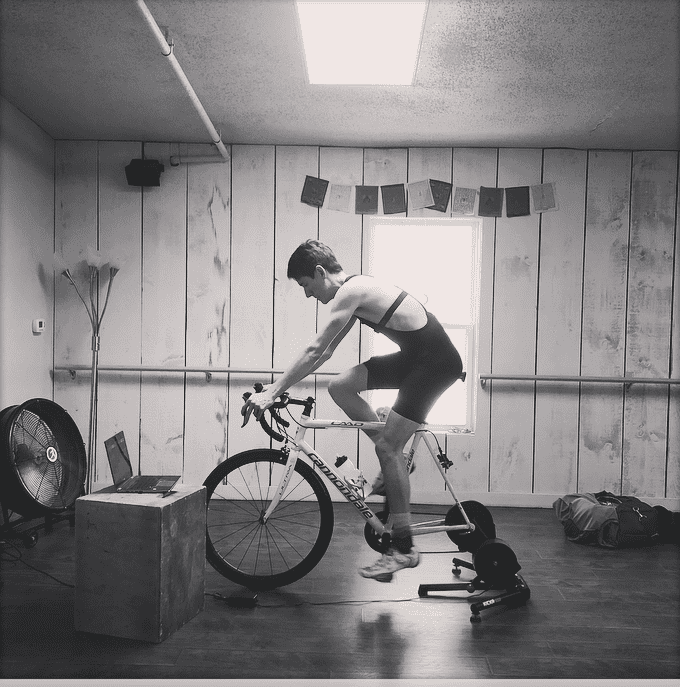You may live in a sunny area with no rain or snow or frigid temperatures. But for the rest of us there is a yearly shift in our training patterns as inclement weather pushes us indoors. There are many reasons you might want to include some indoor training into your routine even if you ‘skip’ winter. This article helps you make the most of your indoor time.
Embrace the chance to ride indoors. There are many advantages to the isolation of the pedaling technique in the absence of (much) balance, traffic or wind. I compare the indoor trainer to a batting-cage or punching-bag. It is not the real sport but it lets you work on an element of the game. For cyclists the element of pedaling against resistance is important, why not isolate it?
Don’t ride like you ride outside
If you ‘just sit there’ you will be bored in approximately 59 seconds, the time it takes to make sure your garmin is setup and the James Bond Movie is at the perfect volume. Rather you *MUST* have a purpose for the ride. While I am not a fan of videos and ‘turn your brain off’ suffer videos (more below), whatever tools you use you should have a purpose for relating to your limiters/goals and should be broken into mini-blocks (intervals). The warm-up, main-workout and cooldown are a basic three-part ride. There can be more divisions but knowing you have 20 minutes of ramping up slowly to a goal Heart Rate over 20 minutes, a 20 minute ‘threshold’ interval and then a 20 minute cool-down with some high-RPM and one-leg work will pass the 1 hour much nicer than staring at a 1 hour timer.
More on Structuring Your Ride
There are some workouts that don’t work as well on the indoor trainer but some that are much better. Why not use the indoor trainer for those things you can’t do outside? You can do a long(ish) endurance ride or cross-train for most of your endurance work but intervals are very nice on a trainer because you have a chance to really dial in the intensity and be steady without concern for cars or other riders. Low RPM, High RPM, One-Leg and short but very hard intervals are great on the trainer.
One-Leg (Isolated Leg) and high cadence drills are common on the trainer because they work really well there (and they break up the time/loading). While the pedal stroke aspect is generally good the bigger reason to do the one leg especially is to learn to interact with your bike in varied situations. If you find yourself falling over on the road/trail, failing to unclip, don’t know what ‘outrigger’ or ‘tripod’ means and/or dread clipping in to start a race then you should do a bunch of one-leg this winter.
Take it Easy, Get some Numbers
Not every ride needs to be long and/or a suffer-festival. Include a couple of 30 minute spins in your week. Do it as a ramp ‘test’. 5 minute stages progressing from 45% FTP up to 70% at end of the 30 minutes. The time goes by fast and you get a mini test of how your HR:Power is progressing. If you don’t suffer everyday you can better work hard and effectively on your limiters a couple times a week without burning out or getting injured. Those hard days should be progressive and be repeatable soon after, if it is so hard you are getting nausea or tasting blood you will be mentally burnt come race season, if not before. save it for race day (note you still work hard just don’t have to be ‘max’ all the time).
Be Cool
Have a big fan. This is important. Use a fan and consider a cold room or garage for your training areas. You likely need a bigger fan. While heat adaptation is a possible intervention for indoor trainer it will definitely make the time FEEL harder and drop your performance (this happens at altitude or in hot environments). It amazes me how many athletes skip the fan but really want their power to increase indoors.
Take a Break
You can get off periodically. Think of how often you coast, soft-pedal, stop to pee, stop for lights, stop for coffee on outdoor-rides. It is ok to stop and do a few strength/mobility motions, go to washroom, refill a bottle, answer the phone. Don’t do it all the time but divide any long-ish rides you do like this and the time goes much quicker and your butt will thank you.
You Don’t Eat an Elephant Whole (or something like that)
The biggest mistake is thinking about the 3 hour workout you have planned. Put your shorts on and get on the bike, starting is the important part.
Use the lap timer not the ride timer. This is a common mistake, the lap timer is important and will make your interval work better. It also prevents you from thinking about the ride as a 2 hour ride. Rather do 15 minute laps broken up by 10 push-ups or coordination drills.
Don’t be so Hard on Yourself
The Trainer is very hard. If you are saying ‘should’ it will make you stressed out. If you have an interval you want to do, ease into it and do what you can on the day. This applies almost always but especially on the trainer where the unrelenting resistance can really clamp down on you quickly if you are a bit fatigue and pushing more than you have on a given day.
Want more great thoughts to make your training better? Have Questions about Training, Nutrition or more awkward questions like Saddle Sores?
Join us on one or all of 3 Nights/Venues = Trek Store Toronto (Tues Dec 6) OR Aurora (Dec 7) OR Barrie (Thurs Dec 8) 2016
A free event! Please bring friends and your questions
Sign up on Facebook at https://www.facebook.com/events/1289415717746062/
Want it now? BUY IT ON AMAZON OR FIND OUT ABOUT THE BOOK





